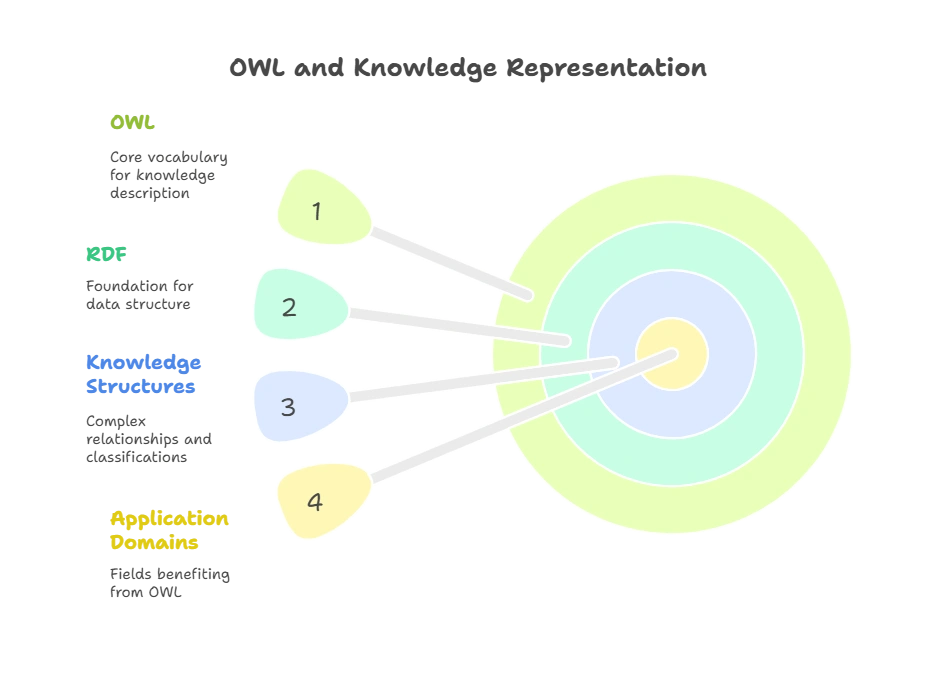OWL (Web Ontology Language in XML)"
The Web Ontology Language (OWL) is a powerful framework for representing knowledge about domains in a structured, machine-interpretable format. Created as part of the Semantic Web initiative by the W3C, OWL builds on RDF and XML to define more complex relationships and hierarchical structures. This chapter covers OWL from its basic concepts to advanced applications, explaining its role in XML, structure, syntax, and practical usage.
Introduction to OWL and Its Purpose
OWL is designed to work in conjunction with RDF to provide a formal vocabulary for describing the relationships and classifications within a domain. OWL is ideal for representing rich and complex knowledge structures, such as those used in biology, geography, social science, and artificial intelligence. By using OWL, developers can define terms, entities, and relationships in a way that allows systems to “understand” the data better.

OWL and XML: The Connection
OWL is commonly serialized using XML syntax, enabling structured and portable data descriptions. OWL can describe classes, properties, individuals, and complex relationships, making it a foundational tool for creating semantic applications.
Benefits of Using OWL with XML:
- Standardization: OWL is an international standard, allowing consistency in data sharing.
- Interoperability: OWL in XML format ensures that data can be exchanged between various applications.
- Semantic Enrichment: By defining meaning explicitly, OWL adds interpretability to XML data.
Key Concepts in OWL
- Classes: Define the categories or types within a domain (e.g., “Animal,” “Person”).
- Individuals: Instances of classes (e.g., “Tiger” as an instance of “Animal”).
- Properties: Describe relationships between classes and individuals, categorized as object properties and data properties.
Example of Basic OWL Syntax in XML
<rdf:RDF xmlns:rdf="http://www.w3.org/1999/02/22-rdf-syntax-ns#"
xmlns:owl="http://www.w3.org/2002/07/owl#"
xmlns:rdfs="http://www.w3.org/2000/01/rdf-schema#">
<owl:Class rdf:about="http://example.org/Animal"/>
<owl:Class rdf:about="http://example.org/Mammal"/>
<rdf:Description rdf:about="http://example.org/Tiger">
<rdf:type rdf:resource="http://example.org/Mammal"/>
</rdf:Description>
</rdf:RDF>
- Explanation:
- Defines
AnimalandMammalas classes. Tigeris an instance of theMammalclass.
- Defines
OWL Class Hierarchies and Relationships
Classes in OWL can have hierarchies, allowing complex definitions. Subclassing allows a class to inherit properties from a parent class.
Example of Subclass in OWL:
<owl:Class rdf:about="http://example.org/Bird"/>
<owl:Class rdf:about="http://example.org/Eagle">
<rdfs:subClassOf rdf:resource="http://example.org/Bird"/>
</owl:Class>
- Explanation:
Eagleis a subclass ofBird, inheriting its properties.
Properties in OWL
Properties describe attributes or relationships. There are two main types:
- Object Properties: Link an individual to another individual.
- Data Properties: Link an individual to a data value (e.g., age, height).
Example of Object and Data Properties in OWL/XML
<owl:ObjectProperty rdf:about="http://example.org/hasFriend"/>
<owl:DatatypeProperty rdf:about="http://example.org/hasAge"/>
<rdf:Description rdf:about="http://example.org/John">
<rdf:type rdf:resource="http://example.org/Person"/>
<hasFriend rdf:resource="http://example.org/Mary"/>
<hasAge rdf:datatype="http://www.w3.org/2001/XMLSchema#integer">30</hasAge>
</rdf:Description>
Explanation:
- Defines
hasFriendas an object property andhasAgeas a data property. - Describes an individual
John, who has a friendMaryand an age of 30.
- Defines
OWL Restrictions and Constraints
OWL allows for defining restrictions to impose rules on properties, such as:
- Cardinality: Specifies the number of times a property can be associated with an individual.
- Value Constraints: Restrict values for properties.
Example of Cardinality in OWL/XML
<owl:Class rdf:about="http://example.org/Parent">
<owl:Restriction>
<owl:onProperty rdf:resource="http://example.org/hasChild"/>
<owl:minCardinality rdf:datatype="http://www.w3.org/2001/XMLSchema#integer">1</owl:minCardinality>
</owl:Restriction>
</owl:Class>
Explanation:
- The restriction specifies that
Parentmust have at least onehasChildrelationship.
- The restriction specifies that
Advanced Features of OWL: Ontology Properties and Inference
OWL supports advanced features like ontology properties and inference rules:
- Ontology Properties: Include annotations, imports, and versioning.
- Inference: Allows reasoning engines to deduce new relationships.
Example of Ontology Property
<owl:Ontology rdf:about="http://example.org/ontology">
<owl:versionInfo>1.0</owl:versionInfo>
</owl:Ontology>
Explanation: Defines version information for the ontology.
Inference and Reasoning in OWL
One of the most powerful features of OWL is its support for reasoning. OWL enables inference engines to deduce relationships that aren’t explicitly stated.
Example of Inference:
If “Eagle” is a subclass of “Bird” and “Bird” is a subclass of “Animal,” then an inference engine can deduce that “Eagle” is also a subclass of “Animal.”
Real-World Applications of OWL
- Healthcare: To model complex relationships between diseases, symptoms, and treatments.
- E-commerce: For product categorization and recommendation engines.
- Geography: To represent locations, coordinates, and geographical features.
Example in OWL/XML for a Healthcare Application
<owl:Class rdf:about="http://example.org/Disease"/>
<owl:Class rdf:about="http://example.org/Symptom"/>
<owl:ObjectProperty rdf:about="http://example.org/hasSymptom"/>
<rdf:Description rdf:about="http://example.org/Flu">
<rdf:type rdf:resource="http://example.org/Disease"/>
<hasSymptom rdf:resource="http://example.org/Fever"/>
</rdf:Description>
Advantages and Challenges of Using OWL with XML
Advantages:
- Expressiveness: OWL offers a powerful language for defining complex knowledge structures.
- Interoperability: OWL ontologies in XML are easily shareable across applications.
- Enhanced Querying: OWL makes data querying and retrieval more accurate.
Challenges:
- Learning Curve: OWL syntax and logic can be complex.
- Performance: Reasoning engines may require significant computational resources.
OWL empowers developers to represent complex knowledge structures and relationships in XML, contributing to the Semantic Web's vision of a machine-interpretable internet. By leveraging OWL with XML, systems can enhance data interpretability, enable advanced querying, and enable the creation of interconnected knowledge graphs. This chapter covers OWL in depth, from core concepts to advanced applications, providing a comprehensive understanding of how OWL supports the Semantic Web and domain-specific ontologies. Happy coding !❤️
